Information System Management: Data Storage, Security and Decisions
VerifiedAdded on 2019/12/03
|12
|3600
|227
Report
AI Summary
This report provides a comprehensive overview of information system management, focusing on database concepts, technical responsibilities of database administrators, and organizational requirements for data storage and information gathering. It delves into the use of gathered database information in managerial decisions, highlighting how data analysis supports effective decision-making. Furthermore, the report examines strategies organizations employ to address security threats to information and databases, emphasizing the importance of data protection. Key topics include database design, data security tools, user right management, and various techniques for collecting and securing data. The report concludes by summarizing the critical aspects of database management and its role in ensuring data security and driving informed decision-making within organizations.
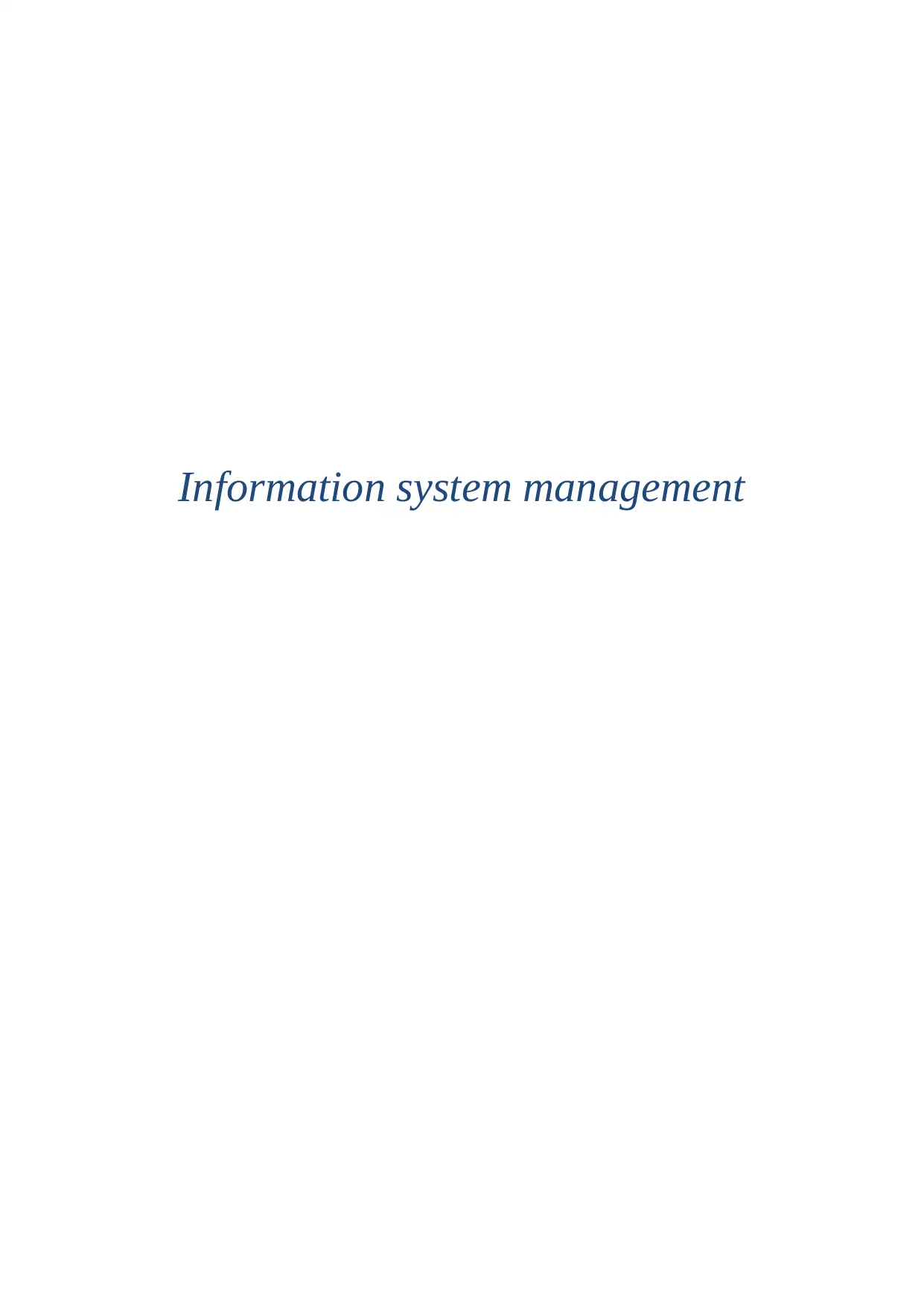
Information system management
Paraphrase This Document
Need a fresh take? Get an instant paraphrase of this document with our AI Paraphraser
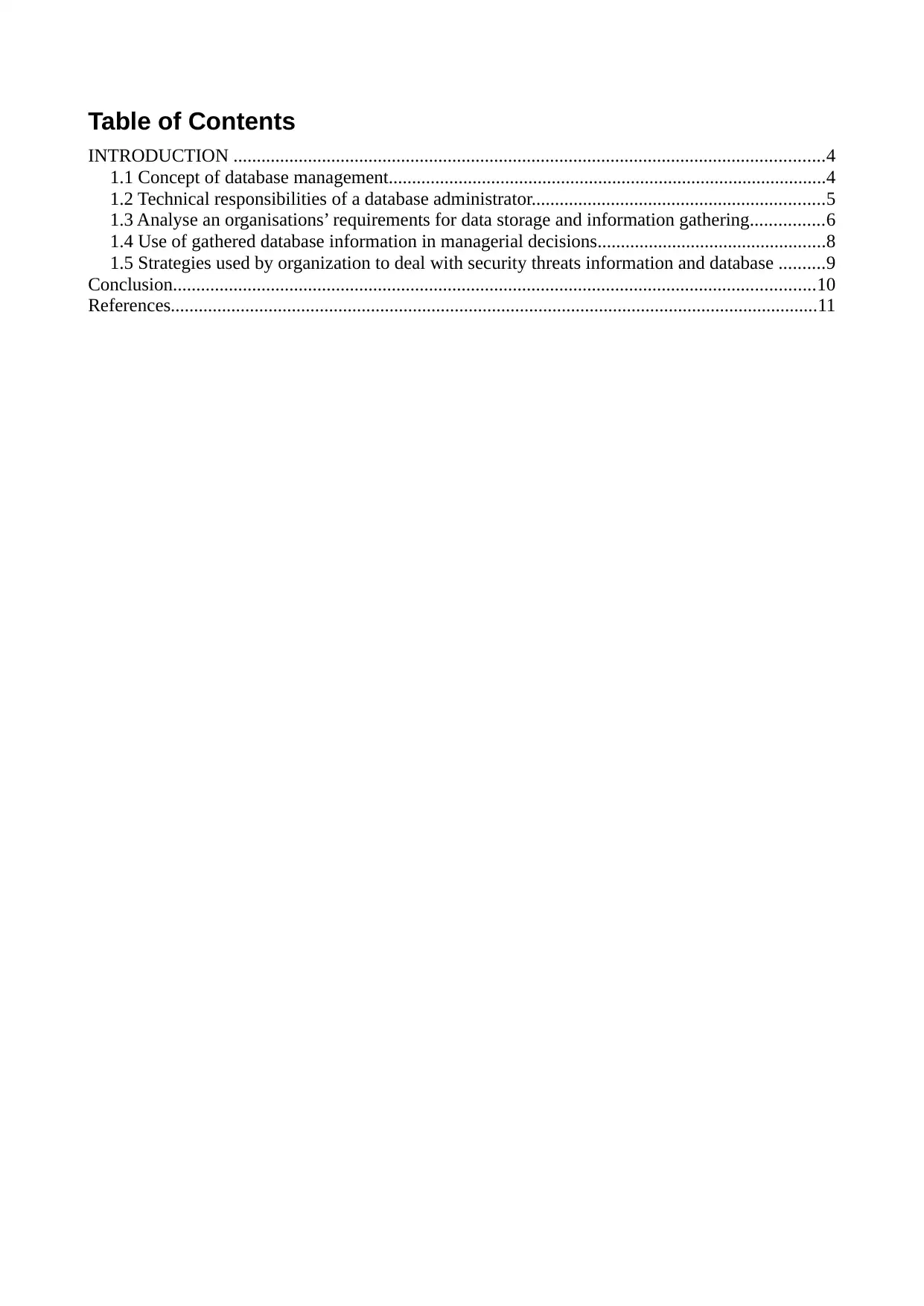
Table of Contents
INTRODUCTION ...............................................................................................................................4
1.1 Concept of database management..............................................................................................4
1.2 Technical responsibilities of a database administrator...............................................................5
1.3 Analyse an organisations’ requirements for data storage and information gathering................6
1.4 Use of gathered database information in managerial decisions.................................................8
1.5 Strategies used by organization to deal with security threats information and database ..........9
Conclusion..........................................................................................................................................10
References...........................................................................................................................................11
INTRODUCTION ...............................................................................................................................4
1.1 Concept of database management..............................................................................................4
1.2 Technical responsibilities of a database administrator...............................................................5
1.3 Analyse an organisations’ requirements for data storage and information gathering................6
1.4 Use of gathered database information in managerial decisions.................................................8
1.5 Strategies used by organization to deal with security threats information and database ..........9
Conclusion..........................................................................................................................................10
References...........................................................................................................................................11

Illustration Index
Illustration 1: DBMS............................................................................................................................5
Illustration 1: DBMS............................................................................................................................5
⊘ This is a preview!⊘
Do you want full access?
Subscribe today to unlock all pages.

Trusted by 1+ million students worldwide
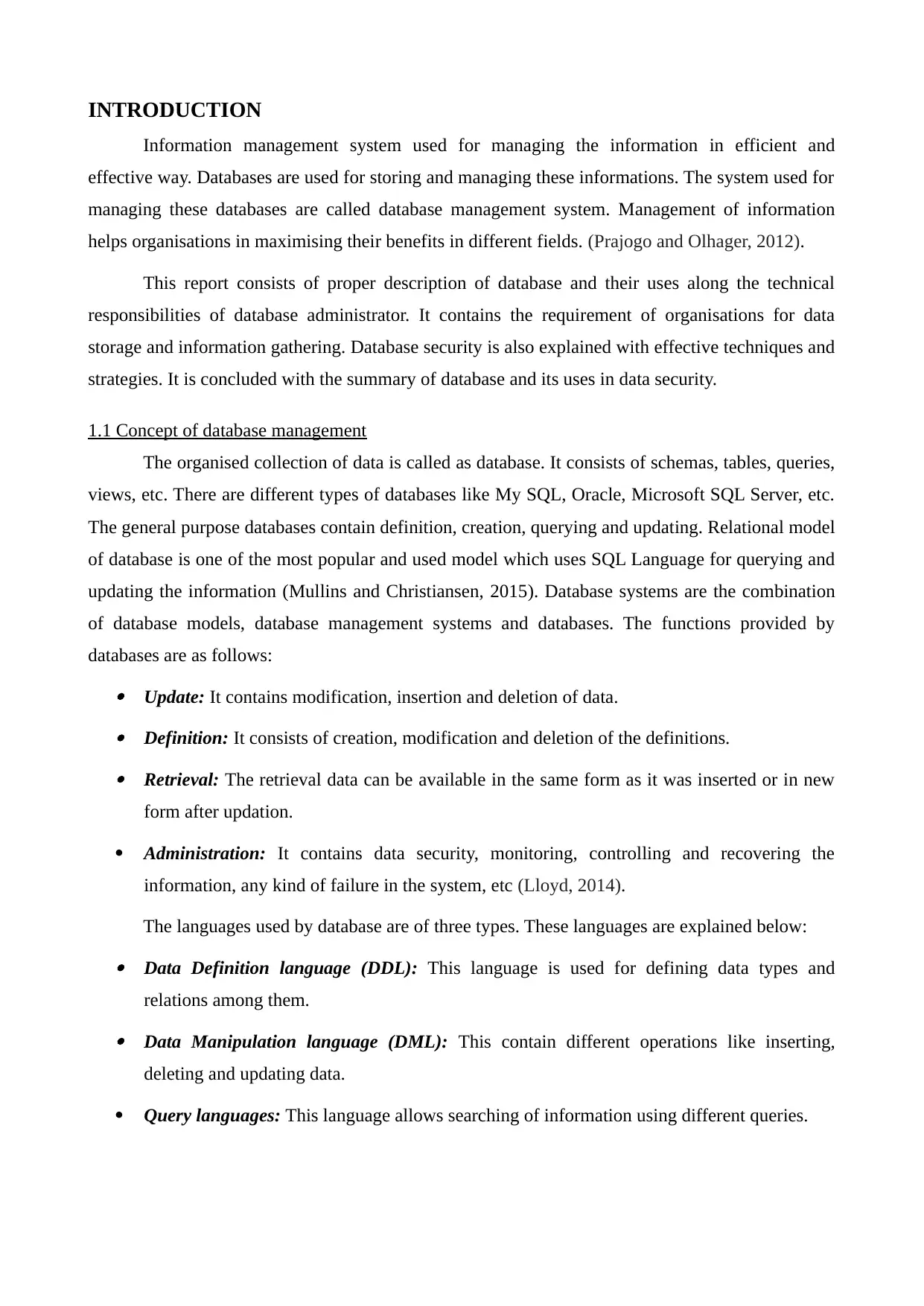
INTRODUCTION
Information management system used for managing the information in efficient and
effective way. Databases are used for storing and managing these informations. The system used for
managing these databases are called database management system. Management of information
helps organisations in maximising their benefits in different fields. (Prajogo and Olhager, 2012).
This report consists of proper description of database and their uses along the technical
responsibilities of database administrator. It contains the requirement of organisations for data
storage and information gathering. Database security is also explained with effective techniques and
strategies. It is concluded with the summary of database and its uses in data security.
1.1 Concept of database management
The organised collection of data is called as database. It consists of schemas, tables, queries,
views, etc. There are different types of databases like My SQL, Oracle, Microsoft SQL Server, etc.
The general purpose databases contain definition, creation, querying and updating. Relational model
of database is one of the most popular and used model which uses SQL Language for querying and
updating the information (Mullins and Christiansen, 2015). Database systems are the combination
of database models, database management systems and databases. The functions provided by
databases are as follows:
Update: It contains modification, insertion and deletion of data.
Definition: It consists of creation, modification and deletion of the definitions.
Retrieval: The retrieval data can be available in the same form as it was inserted or in new
form after updation.
Administration: It contains data security, monitoring, controlling and recovering the
information, any kind of failure in the system, etc (Lloyd, 2014).
The languages used by database are of three types. These languages are explained below:
Data Definition language (DDL): This language is used for defining data types and
relations among them.
Data Manipulation language (DML): This contain different operations like inserting,
deleting and updating data.
Query languages: This language allows searching of information using different queries.
Information management system used for managing the information in efficient and
effective way. Databases are used for storing and managing these informations. The system used for
managing these databases are called database management system. Management of information
helps organisations in maximising their benefits in different fields. (Prajogo and Olhager, 2012).
This report consists of proper description of database and their uses along the technical
responsibilities of database administrator. It contains the requirement of organisations for data
storage and information gathering. Database security is also explained with effective techniques and
strategies. It is concluded with the summary of database and its uses in data security.
1.1 Concept of database management
The organised collection of data is called as database. It consists of schemas, tables, queries,
views, etc. There are different types of databases like My SQL, Oracle, Microsoft SQL Server, etc.
The general purpose databases contain definition, creation, querying and updating. Relational model
of database is one of the most popular and used model which uses SQL Language for querying and
updating the information (Mullins and Christiansen, 2015). Database systems are the combination
of database models, database management systems and databases. The functions provided by
databases are as follows:
Update: It contains modification, insertion and deletion of data.
Definition: It consists of creation, modification and deletion of the definitions.
Retrieval: The retrieval data can be available in the same form as it was inserted or in new
form after updation.
Administration: It contains data security, monitoring, controlling and recovering the
information, any kind of failure in the system, etc (Lloyd, 2014).
The languages used by database are of three types. These languages are explained below:
Data Definition language (DDL): This language is used for defining data types and
relations among them.
Data Manipulation language (DML): This contain different operations like inserting,
deleting and updating data.
Query languages: This language allows searching of information using different queries.
Paraphrase This Document
Need a fresh take? Get an instant paraphrase of this document with our AI Paraphraser
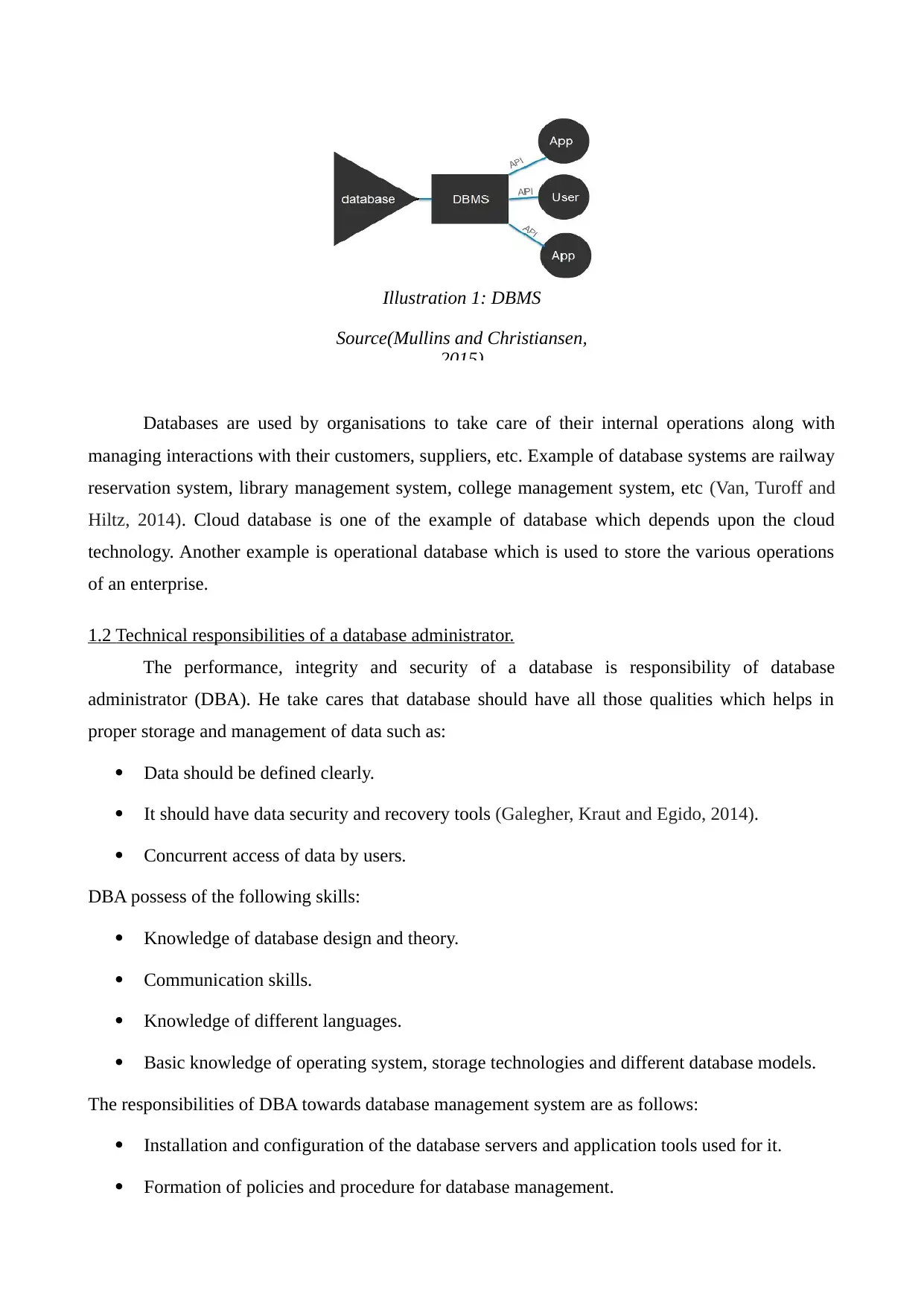
Databases are used by organisations to take care of their internal operations along with
managing interactions with their customers, suppliers, etc. Example of database systems are railway
reservation system, library management system, college management system, etc (Van, Turoff and
Hiltz, 2014). Cloud database is one of the example of database which depends upon the cloud
technology. Another example is operational database which is used to store the various operations
of an enterprise.
1.2 Technical responsibilities of a database administrator.
The performance, integrity and security of a database is responsibility of database
administrator (DBA). He take cares that database should have all those qualities which helps in
proper storage and management of data such as:
Data should be defined clearly.
It should have data security and recovery tools (Galegher, Kraut and Egido, 2014).
Concurrent access of data by users.
DBA possess of the following skills:
Knowledge of database design and theory.
Communication skills.
Knowledge of different languages.
Basic knowledge of operating system, storage technologies and different database models.
The responsibilities of DBA towards database management system are as follows:
Installation and configuration of the database servers and application tools used for it.
Formation of policies and procedure for database management.
Illustration 1: DBMS
Source(Mullins and Christiansen,
2015)
managing interactions with their customers, suppliers, etc. Example of database systems are railway
reservation system, library management system, college management system, etc (Van, Turoff and
Hiltz, 2014). Cloud database is one of the example of database which depends upon the cloud
technology. Another example is operational database which is used to store the various operations
of an enterprise.
1.2 Technical responsibilities of a database administrator.
The performance, integrity and security of a database is responsibility of database
administrator (DBA). He take cares that database should have all those qualities which helps in
proper storage and management of data such as:
Data should be defined clearly.
It should have data security and recovery tools (Galegher, Kraut and Egido, 2014).
Concurrent access of data by users.
DBA possess of the following skills:
Knowledge of database design and theory.
Communication skills.
Knowledge of different languages.
Basic knowledge of operating system, storage technologies and different database models.
The responsibilities of DBA towards database management system are as follows:
Installation and configuration of the database servers and application tools used for it.
Formation of policies and procedure for database management.
Illustration 1: DBMS
Source(Mullins and Christiansen,
2015)
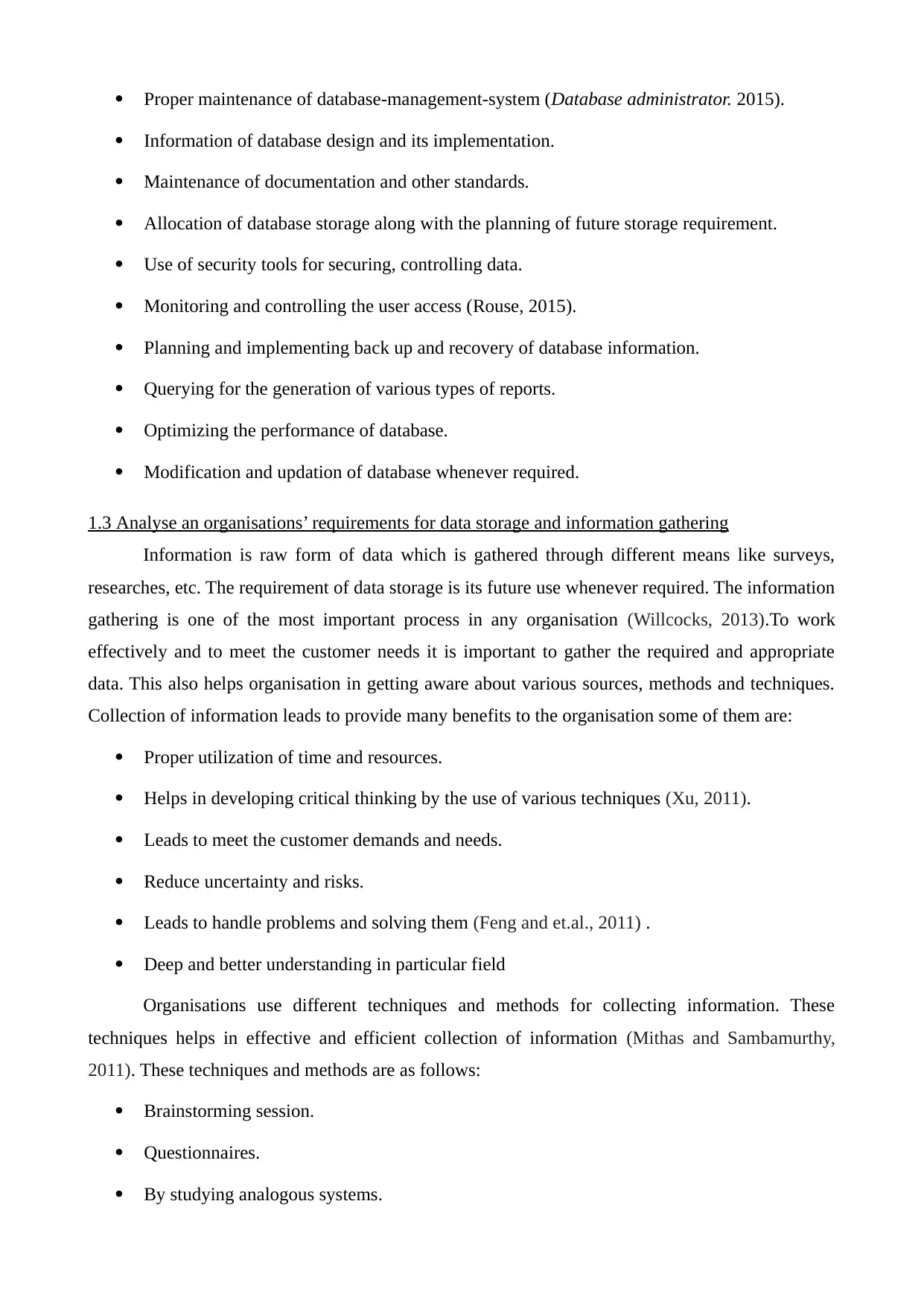
Proper maintenance of database-management-system (Database administrator. 2015).
Information of database design and its implementation.
Maintenance of documentation and other standards.
Allocation of database storage along with the planning of future storage requirement.
Use of security tools for securing, controlling data.
Monitoring and controlling the user access (Rouse, 2015).
Planning and implementing back up and recovery of database information.
Querying for the generation of various types of reports.
Optimizing the performance of database.
Modification and updation of database whenever required.
1.3 Analyse an organisations’ requirements for data storage and information gathering
Information is raw form of data which is gathered through different means like surveys,
researches, etc. The requirement of data storage is its future use whenever required. The information
gathering is one of the most important process in any organisation (Willcocks, 2013).To work
effectively and to meet the customer needs it is important to gather the required and appropriate
data. This also helps organisation in getting aware about various sources, methods and techniques.
Collection of information leads to provide many benefits to the organisation some of them are:
Proper utilization of time and resources.
Helps in developing critical thinking by the use of various techniques (Xu, 2011).
Leads to meet the customer demands and needs.
Reduce uncertainty and risks.
Leads to handle problems and solving them (Feng and et.al., 2011) .
Deep and better understanding in particular field
Organisations use different techniques and methods for collecting information. These
techniques helps in effective and efficient collection of information (Mithas and Sambamurthy,
2011). These techniques and methods are as follows:
Brainstorming session.
Questionnaires.
By studying analogous systems.
Information of database design and its implementation.
Maintenance of documentation and other standards.
Allocation of database storage along with the planning of future storage requirement.
Use of security tools for securing, controlling data.
Monitoring and controlling the user access (Rouse, 2015).
Planning and implementing back up and recovery of database information.
Querying for the generation of various types of reports.
Optimizing the performance of database.
Modification and updation of database whenever required.
1.3 Analyse an organisations’ requirements for data storage and information gathering
Information is raw form of data which is gathered through different means like surveys,
researches, etc. The requirement of data storage is its future use whenever required. The information
gathering is one of the most important process in any organisation (Willcocks, 2013).To work
effectively and to meet the customer needs it is important to gather the required and appropriate
data. This also helps organisation in getting aware about various sources, methods and techniques.
Collection of information leads to provide many benefits to the organisation some of them are:
Proper utilization of time and resources.
Helps in developing critical thinking by the use of various techniques (Xu, 2011).
Leads to meet the customer demands and needs.
Reduce uncertainty and risks.
Leads to handle problems and solving them (Feng and et.al., 2011) .
Deep and better understanding in particular field
Organisations use different techniques and methods for collecting information. These
techniques helps in effective and efficient collection of information (Mithas and Sambamurthy,
2011). These techniques and methods are as follows:
Brainstorming session.
Questionnaires.
By studying analogous systems.
⊘ This is a preview!⊘
Do you want full access?
Subscribe today to unlock all pages.

Trusted by 1+ million students worldwide
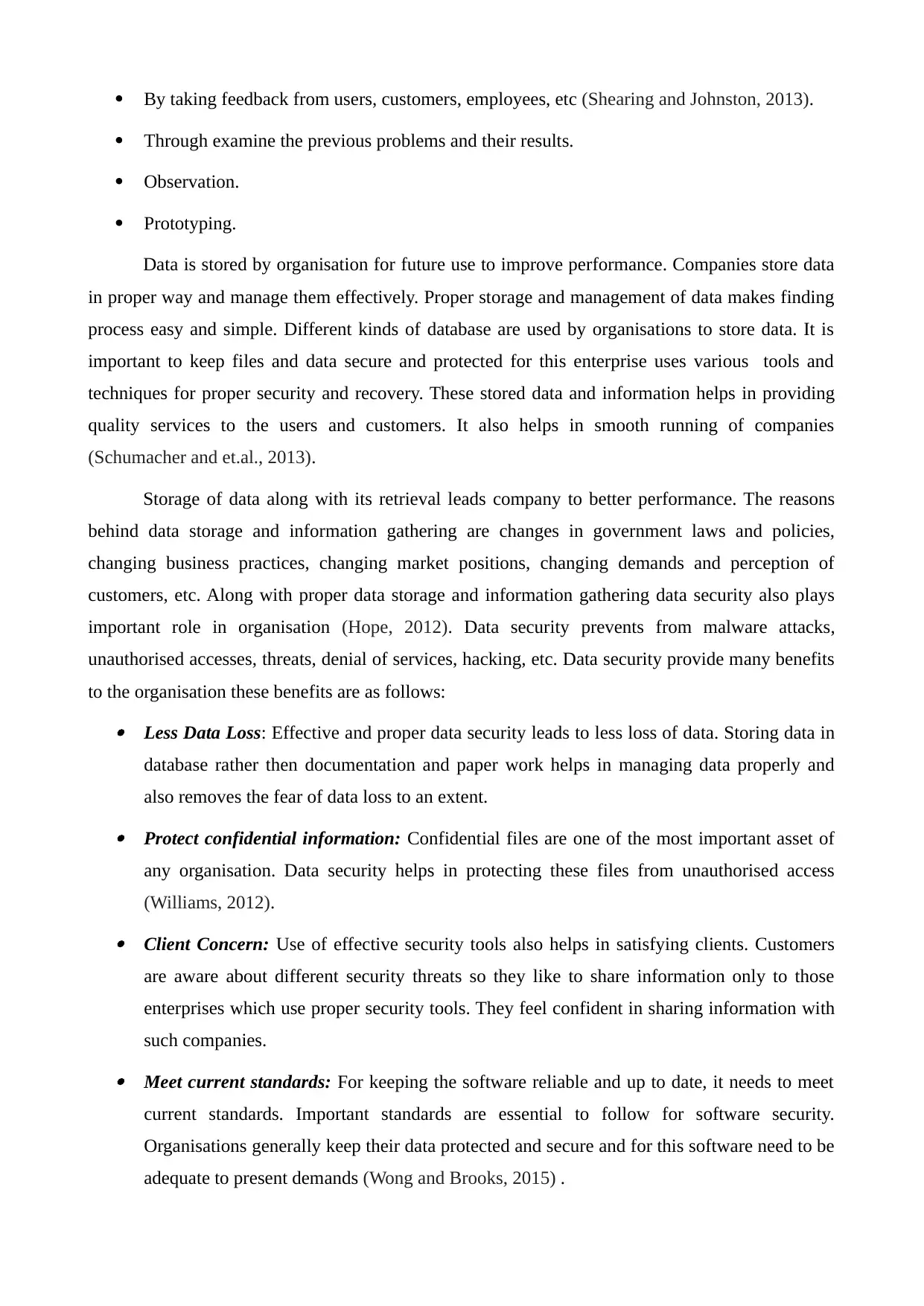
By taking feedback from users, customers, employees, etc (Shearing and Johnston, 2013).
Through examine the previous problems and their results.
Observation.
Prototyping.
Data is stored by organisation for future use to improve performance. Companies store data
in proper way and manage them effectively. Proper storage and management of data makes finding
process easy and simple. Different kinds of database are used by organisations to store data. It is
important to keep files and data secure and protected for this enterprise uses various tools and
techniques for proper security and recovery. These stored data and information helps in providing
quality services to the users and customers. It also helps in smooth running of companies
(Schumacher and et.al., 2013).
Storage of data along with its retrieval leads company to better performance. The reasons
behind data storage and information gathering are changes in government laws and policies,
changing business practices, changing market positions, changing demands and perception of
customers, etc. Along with proper data storage and information gathering data security also plays
important role in organisation (Hope, 2012). Data security prevents from malware attacks,
unauthorised accesses, threats, denial of services, hacking, etc. Data security provide many benefits
to the organisation these benefits are as follows:
Less Data Loss: Effective and proper data security leads to less loss of data. Storing data in
database rather then documentation and paper work helps in managing data properly and
also removes the fear of data loss to an extent.
Protect confidential information: Confidential files are one of the most important asset of
any organisation. Data security helps in protecting these files from unauthorised access
(Williams, 2012).
Client Concern: Use of effective security tools also helps in satisfying clients. Customers
are aware about different security threats so they like to share information only to those
enterprises which use proper security tools. They feel confident in sharing information with
such companies.
Meet current standards: For keeping the software reliable and up to date, it needs to meet
current standards. Important standards are essential to follow for software security.
Organisations generally keep their data protected and secure and for this software need to be
adequate to present demands (Wong and Brooks, 2015) .
Through examine the previous problems and their results.
Observation.
Prototyping.
Data is stored by organisation for future use to improve performance. Companies store data
in proper way and manage them effectively. Proper storage and management of data makes finding
process easy and simple. Different kinds of database are used by organisations to store data. It is
important to keep files and data secure and protected for this enterprise uses various tools and
techniques for proper security and recovery. These stored data and information helps in providing
quality services to the users and customers. It also helps in smooth running of companies
(Schumacher and et.al., 2013).
Storage of data along with its retrieval leads company to better performance. The reasons
behind data storage and information gathering are changes in government laws and policies,
changing business practices, changing market positions, changing demands and perception of
customers, etc. Along with proper data storage and information gathering data security also plays
important role in organisation (Hope, 2012). Data security prevents from malware attacks,
unauthorised accesses, threats, denial of services, hacking, etc. Data security provide many benefits
to the organisation these benefits are as follows:
Less Data Loss: Effective and proper data security leads to less loss of data. Storing data in
database rather then documentation and paper work helps in managing data properly and
also removes the fear of data loss to an extent.
Protect confidential information: Confidential files are one of the most important asset of
any organisation. Data security helps in protecting these files from unauthorised access
(Williams, 2012).
Client Concern: Use of effective security tools also helps in satisfying clients. Customers
are aware about different security threats so they like to share information only to those
enterprises which use proper security tools. They feel confident in sharing information with
such companies.
Meet current standards: For keeping the software reliable and up to date, it needs to meet
current standards. Important standards are essential to follow for software security.
Organisations generally keep their data protected and secure and for this software need to be
adequate to present demands (Wong and Brooks, 2015) .
Paraphrase This Document
Need a fresh take? Get an instant paraphrase of this document with our AI Paraphraser
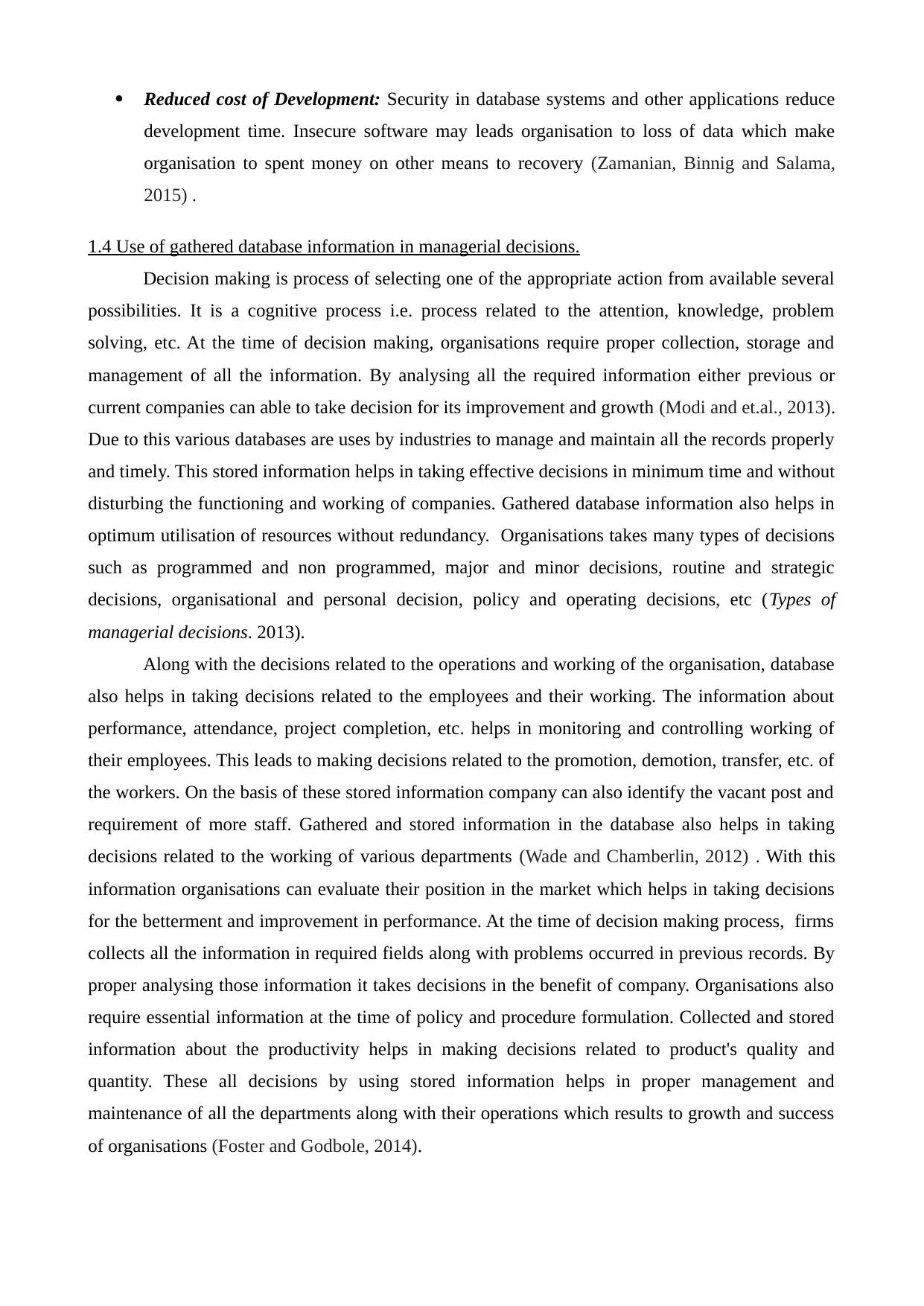
Reduced cost of Development: Security in database systems and other applications reduce
development time. Insecure software may leads organisation to loss of data which make
organisation to spent money on other means to recovery (Zamanian, Binnig and Salama,
2015) .
1.4 Use of gathered database information in managerial decisions.
Decision making is process of selecting one of the appropriate action from available several
possibilities. It is a cognitive process i.e. process related to the attention, knowledge, problem
solving, etc. At the time of decision making, organisations require proper collection, storage and
management of all the information. By analysing all the required information either previous or
current companies can able to take decision for its improvement and growth (Modi and et.al., 2013).
Due to this various databases are uses by industries to manage and maintain all the records properly
and timely. This stored information helps in taking effective decisions in minimum time and without
disturbing the functioning and working of companies. Gathered database information also helps in
optimum utilisation of resources without redundancy. Organisations takes many types of decisions
such as programmed and non programmed, major and minor decisions, routine and strategic
decisions, organisational and personal decision, policy and operating decisions, etc (Types of
managerial decisions. 2013).
Along with the decisions related to the operations and working of the organisation, database
also helps in taking decisions related to the employees and their working. The information about
performance, attendance, project completion, etc. helps in monitoring and controlling working of
their employees. This leads to making decisions related to the promotion, demotion, transfer, etc. of
the workers. On the basis of these stored information company can also identify the vacant post and
requirement of more staff. Gathered and stored information in the database also helps in taking
decisions related to the working of various departments (Wade and Chamberlin, 2012) . With this
information organisations can evaluate their position in the market which helps in taking decisions
for the betterment and improvement in performance. At the time of decision making process, firms
collects all the information in required fields along with problems occurred in previous records. By
proper analysing those information it takes decisions in the benefit of company. Organisations also
require essential information at the time of policy and procedure formulation. Collected and stored
information about the productivity helps in making decisions related to product's quality and
quantity. These all decisions by using stored information helps in proper management and
maintenance of all the departments along with their operations which results to growth and success
of organisations (Foster and Godbole, 2014).
development time. Insecure software may leads organisation to loss of data which make
organisation to spent money on other means to recovery (Zamanian, Binnig and Salama,
2015) .
1.4 Use of gathered database information in managerial decisions.
Decision making is process of selecting one of the appropriate action from available several
possibilities. It is a cognitive process i.e. process related to the attention, knowledge, problem
solving, etc. At the time of decision making, organisations require proper collection, storage and
management of all the information. By analysing all the required information either previous or
current companies can able to take decision for its improvement and growth (Modi and et.al., 2013).
Due to this various databases are uses by industries to manage and maintain all the records properly
and timely. This stored information helps in taking effective decisions in minimum time and without
disturbing the functioning and working of companies. Gathered database information also helps in
optimum utilisation of resources without redundancy. Organisations takes many types of decisions
such as programmed and non programmed, major and minor decisions, routine and strategic
decisions, organisational and personal decision, policy and operating decisions, etc (Types of
managerial decisions. 2013).
Along with the decisions related to the operations and working of the organisation, database
also helps in taking decisions related to the employees and their working. The information about
performance, attendance, project completion, etc. helps in monitoring and controlling working of
their employees. This leads to making decisions related to the promotion, demotion, transfer, etc. of
the workers. On the basis of these stored information company can also identify the vacant post and
requirement of more staff. Gathered and stored information in the database also helps in taking
decisions related to the working of various departments (Wade and Chamberlin, 2012) . With this
information organisations can evaluate their position in the market which helps in taking decisions
for the betterment and improvement in performance. At the time of decision making process, firms
collects all the information in required fields along with problems occurred in previous records. By
proper analysing those information it takes decisions in the benefit of company. Organisations also
require essential information at the time of policy and procedure formulation. Collected and stored
information about the productivity helps in making decisions related to product's quality and
quantity. These all decisions by using stored information helps in proper management and
maintenance of all the departments along with their operations which results to growth and success
of organisations (Foster and Godbole, 2014).
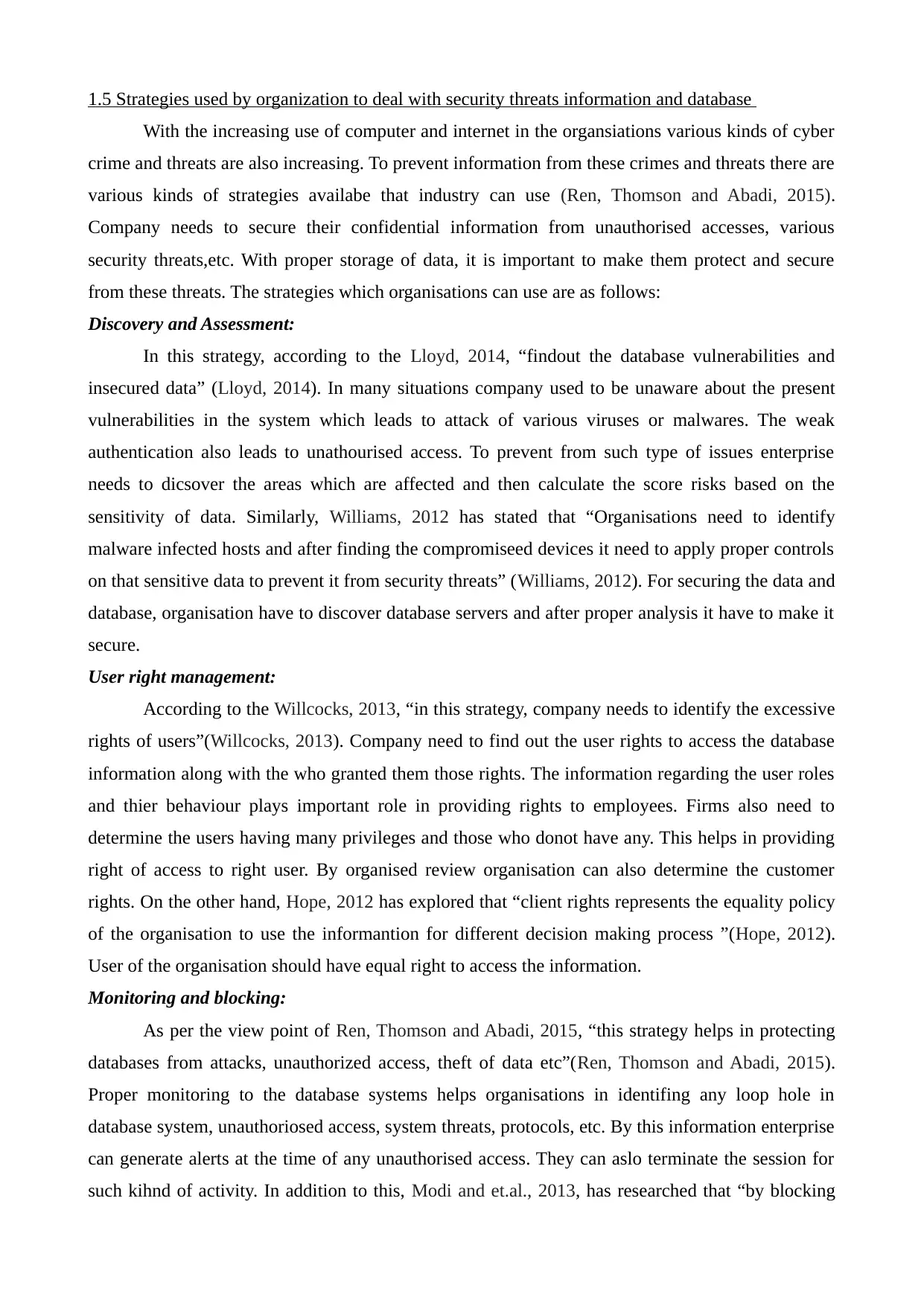
1.5 Strategies used by organization to deal with security threats information and database
With the increasing use of computer and internet in the organsiations various kinds of cyber
crime and threats are also increasing. To prevent information from these crimes and threats there are
various kinds of strategies availabe that industry can use (Ren, Thomson and Abadi, 2015).
Company needs to secure their confidential information from unauthorised accesses, various
security threats,etc. With proper storage of data, it is important to make them protect and secure
from these threats. The strategies which organisations can use are as follows:
Discovery and Assessment:
In this strategy, according to the Lloyd, 2014, “findout the database vulnerabilities and
insecured data” (Lloyd, 2014). In many situations company used to be unaware about the present
vulnerabilities in the system which leads to attack of various viruses or malwares. The weak
authentication also leads to unathourised access. To prevent from such type of issues enterprise
needs to dicsover the areas which are affected and then calculate the score risks based on the
sensitivity of data. Similarly, Williams, 2012 has stated that “Organisations need to identify
malware infected hosts and after finding the compromiseed devices it need to apply proper controls
on that sensitive data to prevent it from security threats” (Williams, 2012). For securing the data and
database, organisation have to discover database servers and after proper analysis it have to make it
secure.
User right management:
According to the Willcocks, 2013, “in this strategy, company needs to identify the excessive
rights of users”(Willcocks, 2013). Company need to find out the user rights to access the database
information along with the who granted them those rights. The information regarding the user roles
and thier behaviour plays important role in providing rights to employees. Firms also need to
determine the users having many privileges and those who donot have any. This helps in providing
right of access to right user. By organised review organisation can also determine the customer
rights. On the other hand, Hope, 2012 has explored that “client rights represents the equality policy
of the organisation to use the informantion for different decision making process ”(Hope, 2012).
User of the organisation should have equal right to access the information.
Monitoring and blocking:
As per the view point of Ren, Thomson and Abadi, 2015, “this strategy helps in protecting
databases from attacks, unauthorized access, theft of data etc”(Ren, Thomson and Abadi, 2015).
Proper monitoring to the database systems helps organisations in identifing any loop hole in
database system, unauthoriosed access, system threats, protocols, etc. By this information enterprise
can generate alerts at the time of any unauthorised access. They can aslo terminate the session for
such kihnd of activity. In addition to this, Modi and et.al., 2013, has researched that “by blocking
With the increasing use of computer and internet in the organsiations various kinds of cyber
crime and threats are also increasing. To prevent information from these crimes and threats there are
various kinds of strategies availabe that industry can use (Ren, Thomson and Abadi, 2015).
Company needs to secure their confidential information from unauthorised accesses, various
security threats,etc. With proper storage of data, it is important to make them protect and secure
from these threats. The strategies which organisations can use are as follows:
Discovery and Assessment:
In this strategy, according to the Lloyd, 2014, “findout the database vulnerabilities and
insecured data” (Lloyd, 2014). In many situations company used to be unaware about the present
vulnerabilities in the system which leads to attack of various viruses or malwares. The weak
authentication also leads to unathourised access. To prevent from such type of issues enterprise
needs to dicsover the areas which are affected and then calculate the score risks based on the
sensitivity of data. Similarly, Williams, 2012 has stated that “Organisations need to identify
malware infected hosts and after finding the compromiseed devices it need to apply proper controls
on that sensitive data to prevent it from security threats” (Williams, 2012). For securing the data and
database, organisation have to discover database servers and after proper analysis it have to make it
secure.
User right management:
According to the Willcocks, 2013, “in this strategy, company needs to identify the excessive
rights of users”(Willcocks, 2013). Company need to find out the user rights to access the database
information along with the who granted them those rights. The information regarding the user roles
and thier behaviour plays important role in providing rights to employees. Firms also need to
determine the users having many privileges and those who donot have any. This helps in providing
right of access to right user. By organised review organisation can also determine the customer
rights. On the other hand, Hope, 2012 has explored that “client rights represents the equality policy
of the organisation to use the informantion for different decision making process ”(Hope, 2012).
User of the organisation should have equal right to access the information.
Monitoring and blocking:
As per the view point of Ren, Thomson and Abadi, 2015, “this strategy helps in protecting
databases from attacks, unauthorized access, theft of data etc”(Ren, Thomson and Abadi, 2015).
Proper monitoring to the database systems helps organisations in identifing any loop hole in
database system, unauthoriosed access, system threats, protocols, etc. By this information enterprise
can generate alerts at the time of any unauthorised access. They can aslo terminate the session for
such kihnd of activity. In addition to this, Modi and et.al., 2013, has researched that “by blocking
⊘ This is a preview!⊘
Do you want full access?
Subscribe today to unlock all pages.

Trusted by 1+ million students worldwide
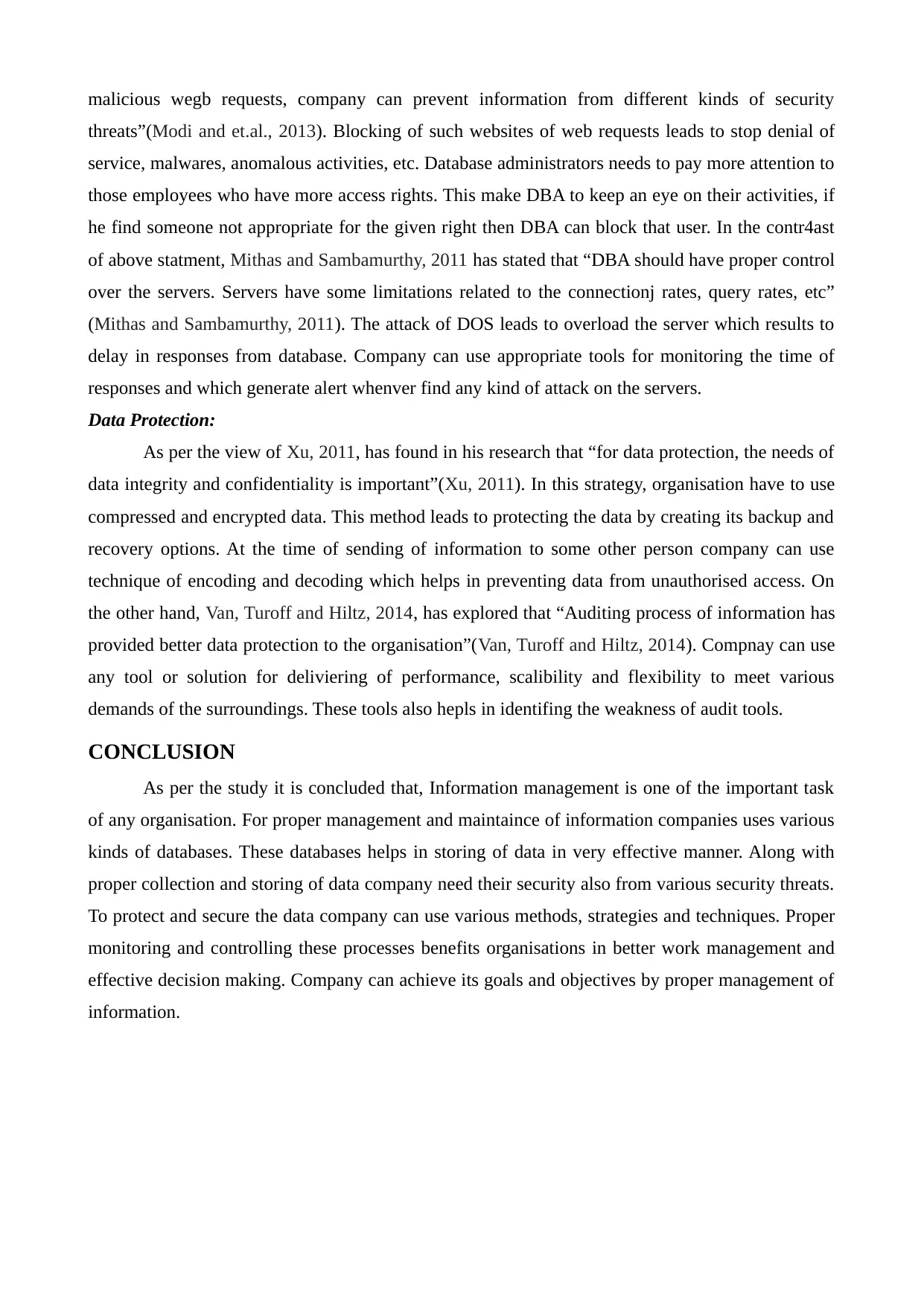
malicious wegb requests, company can prevent information from different kinds of security
threats”(Modi and et.al., 2013). Blocking of such websites of web requests leads to stop denial of
service, malwares, anomalous activities, etc. Database administrators needs to pay more attention to
those employees who have more access rights. This make DBA to keep an eye on their activities, if
he find someone not appropriate for the given right then DBA can block that user. In the contr4ast
of above statment, Mithas and Sambamurthy, 2011 has stated that “DBA should have proper control
over the servers. Servers have some limitations related to the connectionj rates, query rates, etc”
(Mithas and Sambamurthy, 2011). The attack of DOS leads to overload the server which results to
delay in responses from database. Company can use appropriate tools for monitoring the time of
responses and which generate alert whenver find any kind of attack on the servers.
Data Protection:
As per the view of Xu, 2011, has found in his research that “for data protection, the needs of
data integrity and confidentiality is important”(Xu, 2011). In this strategy, organisation have to use
compressed and encrypted data. This method leads to protecting the data by creating its backup and
recovery options. At the time of sending of information to some other person company can use
technique of encoding and decoding which helps in preventing data from unauthorised access. On
the other hand, Van, Turoff and Hiltz, 2014, has explored that “Auditing process of information has
provided better data protection to the organisation”(Van, Turoff and Hiltz, 2014). Compnay can use
any tool or solution for deliviering of performance, scalibility and flexibility to meet various
demands of the surroundings. These tools also hepls in identifing the weakness of audit tools.
CONCLUSION
As per the study it is concluded that, Information management is one of the important task
of any organisation. For proper management and maintaince of information companies uses various
kinds of databases. These databases helps in storing of data in very effective manner. Along with
proper collection and storing of data company need their security also from various security threats.
To protect and secure the data company can use various methods, strategies and techniques. Proper
monitoring and controlling these processes benefits organisations in better work management and
effective decision making. Company can achieve its goals and objectives by proper management of
information.
threats”(Modi and et.al., 2013). Blocking of such websites of web requests leads to stop denial of
service, malwares, anomalous activities, etc. Database administrators needs to pay more attention to
those employees who have more access rights. This make DBA to keep an eye on their activities, if
he find someone not appropriate for the given right then DBA can block that user. In the contr4ast
of above statment, Mithas and Sambamurthy, 2011 has stated that “DBA should have proper control
over the servers. Servers have some limitations related to the connectionj rates, query rates, etc”
(Mithas and Sambamurthy, 2011). The attack of DOS leads to overload the server which results to
delay in responses from database. Company can use appropriate tools for monitoring the time of
responses and which generate alert whenver find any kind of attack on the servers.
Data Protection:
As per the view of Xu, 2011, has found in his research that “for data protection, the needs of
data integrity and confidentiality is important”(Xu, 2011). In this strategy, organisation have to use
compressed and encrypted data. This method leads to protecting the data by creating its backup and
recovery options. At the time of sending of information to some other person company can use
technique of encoding and decoding which helps in preventing data from unauthorised access. On
the other hand, Van, Turoff and Hiltz, 2014, has explored that “Auditing process of information has
provided better data protection to the organisation”(Van, Turoff and Hiltz, 2014). Compnay can use
any tool or solution for deliviering of performance, scalibility and flexibility to meet various
demands of the surroundings. These tools also hepls in identifing the weakness of audit tools.
CONCLUSION
As per the study it is concluded that, Information management is one of the important task
of any organisation. For proper management and maintaince of information companies uses various
kinds of databases. These databases helps in storing of data in very effective manner. Along with
proper collection and storing of data company need their security also from various security threats.
To protect and secure the data company can use various methods, strategies and techniques. Proper
monitoring and controlling these processes benefits organisations in better work management and
effective decision making. Company can achieve its goals and objectives by proper management of
information.
Paraphrase This Document
Need a fresh take? Get an instant paraphrase of this document with our AI Paraphraser
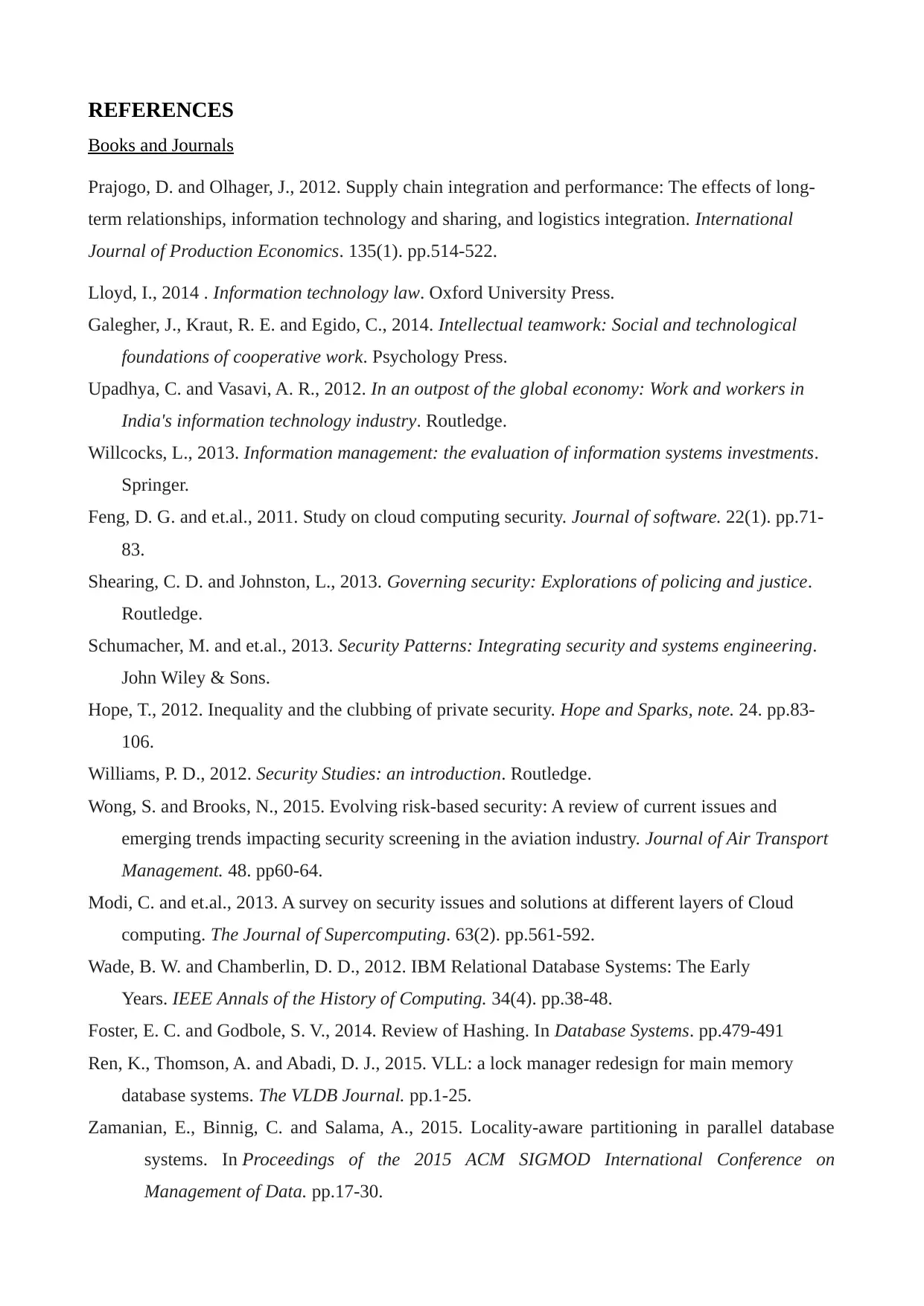
REFERENCES
Books and Journals
Prajogo, D. and Olhager, J., 2012. Supply chain integration and performance: The effects of long-
term relationships, information technology and sharing, and logistics integration. International
Journal of Production Economics. 135(1). pp.514-522.
Lloyd, I., 2014 . Information technology law. Oxford University Press.
Galegher, J., Kraut, R. E. and Egido, C., 2014. Intellectual teamwork: Social and technological
foundations of cooperative work. Psychology Press.
Upadhya, C. and Vasavi, A. R., 2012. In an outpost of the global economy: Work and workers in
India's information technology industry. Routledge.
Willcocks, L., 2013. Information management: the evaluation of information systems investments.
Springer.
Feng, D. G. and et.al., 2011. Study on cloud computing security. Journal of software. 22(1). pp.71-
83.
Shearing, C. D. and Johnston, L., 2013. Governing security: Explorations of policing and justice.
Routledge.
Schumacher, M. and et.al., 2013. Security Patterns: Integrating security and systems engineering.
John Wiley & Sons.
Hope, T., 2012. Inequality and the clubbing of private security. Hope and Sparks, note. 24. pp.83-
106.
Williams, P. D., 2012. Security Studies: an introduction. Routledge.
Wong, S. and Brooks, N., 2015. Evolving risk-based security: A review of current issues and
emerging trends impacting security screening in the aviation industry. Journal of Air Transport
Management. 48. pp60-64.
Modi, C. and et.al., 2013. A survey on security issues and solutions at different layers of Cloud
computing. The Journal of Supercomputing. 63(2). pp.561-592.
Wade, B. W. and Chamberlin, D. D., 2012. IBM Relational Database Systems: The Early
Years. IEEE Annals of the History of Computing. 34(4). pp.38-48.
Foster, E. C. and Godbole, S. V., 2014. Review of Hashing. In Database Systems. pp.479-491
Ren, K., Thomson, A. and Abadi, D. J., 2015. VLL: a lock manager redesign for main memory
database systems. The VLDB Journal. pp.1-25.
Zamanian, E., Binnig, C. and Salama, A., 2015. Locality-aware partitioning in parallel database
systems. In Proceedings of the 2015 ACM SIGMOD International Conference on
Management of Data. pp.17-30.
Books and Journals
Prajogo, D. and Olhager, J., 2012. Supply chain integration and performance: The effects of long-
term relationships, information technology and sharing, and logistics integration. International
Journal of Production Economics. 135(1). pp.514-522.
Lloyd, I., 2014 . Information technology law. Oxford University Press.
Galegher, J., Kraut, R. E. and Egido, C., 2014. Intellectual teamwork: Social and technological
foundations of cooperative work. Psychology Press.
Upadhya, C. and Vasavi, A. R., 2012. In an outpost of the global economy: Work and workers in
India's information technology industry. Routledge.
Willcocks, L., 2013. Information management: the evaluation of information systems investments.
Springer.
Feng, D. G. and et.al., 2011. Study on cloud computing security. Journal of software. 22(1). pp.71-
83.
Shearing, C. D. and Johnston, L., 2013. Governing security: Explorations of policing and justice.
Routledge.
Schumacher, M. and et.al., 2013. Security Patterns: Integrating security and systems engineering.
John Wiley & Sons.
Hope, T., 2012. Inequality and the clubbing of private security. Hope and Sparks, note. 24. pp.83-
106.
Williams, P. D., 2012. Security Studies: an introduction. Routledge.
Wong, S. and Brooks, N., 2015. Evolving risk-based security: A review of current issues and
emerging trends impacting security screening in the aviation industry. Journal of Air Transport
Management. 48. pp60-64.
Modi, C. and et.al., 2013. A survey on security issues and solutions at different layers of Cloud
computing. The Journal of Supercomputing. 63(2). pp.561-592.
Wade, B. W. and Chamberlin, D. D., 2012. IBM Relational Database Systems: The Early
Years. IEEE Annals of the History of Computing. 34(4). pp.38-48.
Foster, E. C. and Godbole, S. V., 2014. Review of Hashing. In Database Systems. pp.479-491
Ren, K., Thomson, A. and Abadi, D. J., 2015. VLL: a lock manager redesign for main memory
database systems. The VLDB Journal. pp.1-25.
Zamanian, E., Binnig, C. and Salama, A., 2015. Locality-aware partitioning in parallel database
systems. In Proceedings of the 2015 ACM SIGMOD International Conference on
Management of Data. pp.17-30.
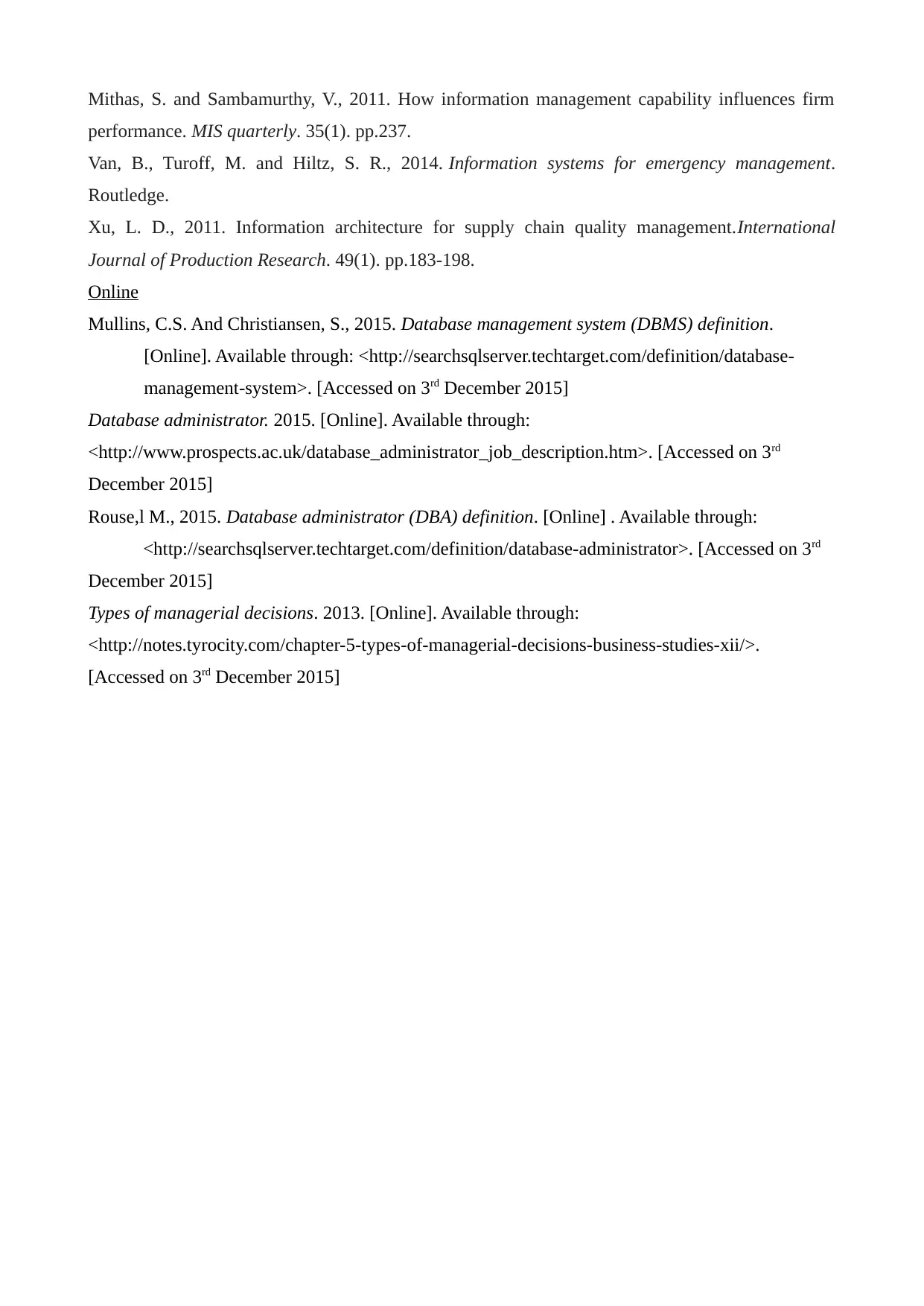
Mithas, S. and Sambamurthy, V., 2011. How information management capability influences firm
performance. MIS quarterly. 35(1). pp.237.
Van, B., Turoff, M. and Hiltz, S. R., 2014. Information systems for emergency management.
Routledge.
Xu, L. D., 2011. Information architecture for supply chain quality management.International
Journal of Production Research. 49(1). pp.183-198.
Online
Mullins, C.S. And Christiansen, S., 2015. Database management system (DBMS) definition.
[Online]. Available through: <http://searchsqlserver.techtarget.com/definition/database-
management-system>. [Accessed on 3rd December 2015]
Database administrator. 2015. [Online]. Available through:
<http://www.prospects.ac.uk/database_administrator_job_description.htm>. [Accessed on 3rd
December 2015]
Rouse,l M., 2015. Database administrator (DBA) definition. [Online] . Available through:
<http://searchsqlserver.techtarget.com/definition/database-administrator>. [Accessed on 3rd
December 2015]
Types of managerial decisions. 2013. [Online]. Available through:
<http://notes.tyrocity.com/chapter-5-types-of-managerial-decisions-business-studies-xii/>.
[Accessed on 3rd December 2015]
performance. MIS quarterly. 35(1). pp.237.
Van, B., Turoff, M. and Hiltz, S. R., 2014. Information systems for emergency management.
Routledge.
Xu, L. D., 2011. Information architecture for supply chain quality management.International
Journal of Production Research. 49(1). pp.183-198.
Online
Mullins, C.S. And Christiansen, S., 2015. Database management system (DBMS) definition.
[Online]. Available through: <http://searchsqlserver.techtarget.com/definition/database-
management-system>. [Accessed on 3rd December 2015]
Database administrator. 2015. [Online]. Available through:
<http://www.prospects.ac.uk/database_administrator_job_description.htm>. [Accessed on 3rd
December 2015]
Rouse,l M., 2015. Database administrator (DBA) definition. [Online] . Available through:
<http://searchsqlserver.techtarget.com/definition/database-administrator>. [Accessed on 3rd
December 2015]
Types of managerial decisions. 2013. [Online]. Available through:
<http://notes.tyrocity.com/chapter-5-types-of-managerial-decisions-business-studies-xii/>.
[Accessed on 3rd December 2015]
⊘ This is a preview!⊘
Do you want full access?
Subscribe today to unlock all pages.

Trusted by 1+ million students worldwide
1 out of 12
Related Documents
Your All-in-One AI-Powered Toolkit for Academic Success.
+13062052269
info@desklib.com
Available 24*7 on WhatsApp / Email
![[object Object]](/_next/static/media/star-bottom.7253800d.svg)
Unlock your academic potential
Copyright © 2020–2025 A2Z Services. All Rights Reserved. Developed and managed by ZUCOL.





